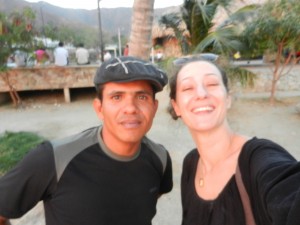 Former Miami Correctional Institute inmate number 26623-069 was convicted in 2000 for narco-trafficking when his fishing boat was found off the coast of Puerto Rico with “a lot” of marijuana and cocaine on board. In February 2007, he was released from the United States penal system and put on a direct flight back to his homeland, Colombia – where he eventually wound up in Santa Marta, the Colombian Riviera – and birthplace of Colombia’s narco-trafficking. Probably not the smoothest move for a man claiming to be set on reform.
Former Miami Correctional Institute inmate number 26623-069 was convicted in 2000 for narco-trafficking when his fishing boat was found off the coast of Puerto Rico with “a lot” of marijuana and cocaine on board. In February 2007, he was released from the United States penal system and put on a direct flight back to his homeland, Colombia – where he eventually wound up in Santa Marta, the Colombian Riviera – and birthplace of Colombia’s narco-trafficking. Probably not the smoothest move for a man claiming to be set on reform.
At around five feet, nine inches, Juan looks back on his time in Miami with nostalgia. “I learned English (in prison) and got my GED. They treated me better than my mother – they fed me three meals a day, gave me clean clothes and counted me like a diamond every night.”
Once a foot soldier in the narco-trafficking that defines Colombia’s history, Juan swears he’s now straight, interested only in tourism – the Colombian government’s new tactic in winning the drug wars – but that doesn’t explain the bullet scar below his left shoulder he got just ten months ago or the more recent scar that runs from his sternum down past his navel.
“Oh that?” Juan asks. “I was carrying a kilo for a friend and the cops came after me – so I ran and they shot.”
“I thought you weren’t into drugs anymore,” I said.
“I’m not, it was just a favor for a friend.”
“Okay…”
 Half an hour later, back on the beach while drinking a potent concoction called Coco Loco, Juan is approached by several tourists looking for drugs.
Half an hour later, back on the beach while drinking a potent concoction called Coco Loco, Juan is approached by several tourists looking for drugs.
“You must have a look about you,” I quip.
“Assholes,” Juan says, taking another sip of his Coco Loco.
I was in Santa Marta for a story – I’d heard there was a cocaine factory I could visit (turns out it had been blown up a month before) – and when that didn’t work out, I hired Juan to show me around the area which, just five years ago, was a hotbed of narcos. In Juan’s defense, the majority of the men in the area used to be in the drug trade before tourism took over.
“There were only four jobs available to us if you wanted to feed your family,” Juan said. “Police officer, army, paratrooper and narco. And they were all basically the same thing.”

This place was a fancy “hostel” at the edge of Taganga Beach that had just been busted for prostitution and drugs (the police barricades were still outside, but it was open nonetheless). To get in you have to go through two sets of eight inch thick double wooden doors. Cameras are EVERYWHERE and it was full of Euro men and local ladies, drinking, playing pool and frolicking in a pool. When I left I was followed by two men with guns down the driveway.
Juan took me on a tour of the gang areas, the beaches of Taganga (now run by Israeli mafia) and Tayrona State Park, pointing out the history along the way (“Over there six bodies washed up with half a ton of cocaine…”, “Oh look, they’re doing a bust now – keep your head down”, “They said if we come any closer they will shoot”).
The day of my departure, I ran into a friend of Juan’s who said, “Juan left a shoe box with me – said it was his flip flops and to hold it for him. Turns out it’s a box of marijuana.” He shook his head and giggled, “That Juan!”
Below: Pics of Taganga Beach where anything can (and does) happen.

Grab one of these fishing boats and have them take you to Tayrona State PArk – where Colombians vacation. For $3 you can get a beer and a fish, right out of the ocean. YUM!




Amazing story. Again: so much better than anything on the Travel Channel right now.
thanks ron – spread the word!